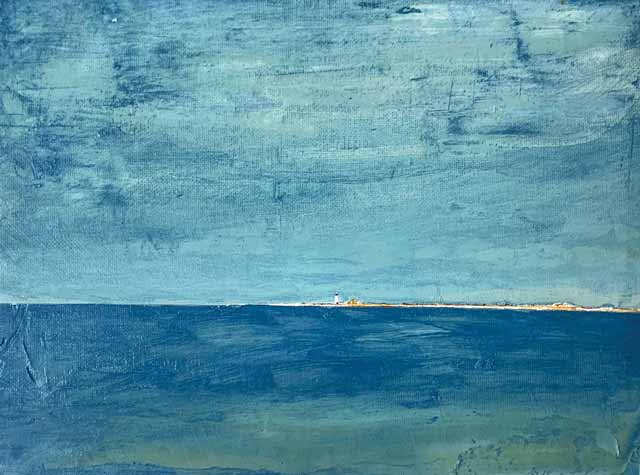by Rebecca M. Alvin
The muted, blue-gray images of the late Arthur Cohen are recognizable anywhere. Throughout a career of more than 50 years, his style and artistic concerns with light, composition, and time have remained consistent. His paintings were often works-in-progress for months or years, as he went back over them, refining them to more accurately reflect his view of his subjects.
“Arthur essentially never left anything alone,” says Jim Bakker, owner of Bakker Gallery, which represents Cohen’s Estate now and currently features him in both a live and virtual exhibition through August 22. “If he pulled out a painting and he was looking at it, and there was something he thought was off, sometimes you’ll see on the back it was started in 1985 and went to 1987, and a lot of it was that he just couldn’t let go of his paintings.”
Even the actual subjects of his paintings are places and iconic structures he returns to again and again. For example, the Brooklyn Bridge. Cohen, a native New Yorker from the Bronx, returned repeatedly to this bridge, often depicting it through compositional devices that use it as a frame for its surroundings.
Likewise, Cohen, who painted in Provincetown and New York equally for over 50 years, painted the Bay, MacMillan Wharf, and the Long Point Lighthouse over and over again. Each painting utilizes the same characteristic palette of blues and grays and greens, that overall subdued tonal quality, and yet there are subtle and essential differences, particularly with regard to light, that ever-changing aspect of any scene.
“I wanted to use a couple of examples where he constantly went back to the same subject,” says Spencer Keasey, managing director of the Gallery and also the curator of this show. The Gallery mounts a solo exhibition of his work just about every year, but this is the first time Keasey has curated it, and he points out a couple of differences.
“None of them have really been in a show before. Some of them I pulled out of the Estate just this spring, so a lot have not even been seen, period, by the public… But this is the first time these have been put together in this way, and I tried to separate it into his two lives,” Keasey explains as he points out the flow of paintings on the wall, one side with New York paintings and the other side paintings of Provincetown, highlighting the central placement of Bus in Provincetown, giving the whole assembly a narrative arc.
While the subject matter is often revisited, Cohen brings a fresh perspective each time, as exemplified by two paintings in the show of the World Trade Center towers, one painted in 1983 and the other in November 2001, when of course, the towers were no longer there, but remained in his consciousness.
“He talked about ghost images. So he would create images that he could keep from memory or the initial piece that he put onto a painting, and then come back and paint over it and sometimes it wasn’t even the same subject or object. But I like this idea of the ghost images,” says Keasey, gesturing toward those World Trade Center paintings as a perfect example.
Aside from temporal context, Cohen’s perspective shifts also with the light and the texture of built up layers of paint, palette knife scratches, and his consciously limited palette. His paintings of MacMillan Pier are interesting because the larger shapes in the foreground are painted as big blocks of their muted color, and then off in the distance, the wharfhouse, the lighthouse, the small structures are painted with the tiniest details, in contrast to how we ordinarily see things. It’s as though the smallest object in the painting is actually the focal point.
Just as New York City and Provincetown are intrinsically linked, yet entirely different environments, Cohen’s paintings of each seem to be part of the same conversation. This can be seen plainly comparing Long Point (2000) with NYC Harbor from Battery Park (year unknown). The former depicts the very tip of Provincetown extending out across the bay, as seen from the shore, while the latter show a view of the Statue of Liberty in New York Harbor with nearly identical composition, as though they were actually meant as companion pieces depicting the two places he lived.
Bakker has shown Cohen’s work since 1992, when the artist approached him about representation, even as he was already being shown at numerous galleries in Provincetown and in New York. “I first met Arthur when I had my gallery on Newbury Street [in Boston] and he sent me a copy of Provincetown Arts magazine back in 1996 when we had
the back cover of the magazine. And there was a list of Provincetown painters. He sent a thing: ‘Who’s missing?’” Bakker recalls with a laugh. After that they began showing his work little by little.
Cohen’s images speak to many and they are well loved both locally and in the larger art enclaves, with work included in collections at the Metropolitan Museum of Art, the Hirshhorn, and the Museum of Fine Arts, Boston, to name a few. He was a Guggenheim Award recipient in 1981 and also received accolades and awards from many other institutions. But his appeal in Provincetown is often tied to his authenticity, both as a person many people knew and loved and as an artist who never wavered from that singular vision.
Arthur Cohen: New York to Provincetown is on view through August 22 at Bakker Gallery, 359 Commercial St., Provincetown, as well as online at bakkerproject.com. For more information, visit the website or call 508.413.9757.













